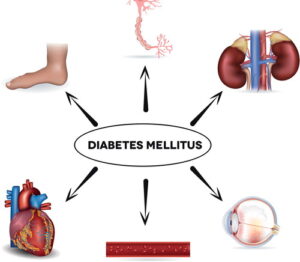Diabetes mellitus, commonly known as diabetes, is a chronic metabolic disorder characterized by elevated blood glucose levels. Managing diabetes involves a multi-faceted approach, including lifestyle modifications, dietary changes, and, in many cases, medications. In this blog, we will delve into the diverse array of medications for Diabetes Mellitus , exploring their mechanisms of action, benefits, and potential side effects.
Contents
- 1 What is Diabetes Mellitus?
- 2 List of Diabetes Mellitus Medications
- 2.1 1. Metformin (Biguanide Class)
- 2.2 2. Sulfonylureas
- 2.3 3. Dipeptidyl Peptidase-4 (DPP-4) Inhibitors
- 2.4 4. SGLT2 Inhibitors (Sodium-Glucose Co-Transporter 2)
- 2.5 5. Insulin
- 2.6 6. Thiazolidinediones (TZDs)
- 2.7 7. GLP-1 Receptor Agonists
- 2.8 8. Alpha-Glucosidase Inhibitors
- 2.9 9. Meglitinides
- 2.10 10. Bile Acid Sequestrants
- 2.11 11. Combinations of Medications
- 2.12 12. Amylin Analogs
- 2.13 13. Fixed-Dose Combination (FDC) Products
- 3 Mechanism of Diabetes Mellitus Medications
- 4 Conclusion
What is Diabetes Mellitus?

Diabetes mellitus, commonly referred to as diabetes, is a chronic metabolic disorder characterized by elevated levels of glucose (sugar) in the blood. This condition arises when the body either cannot produce enough insulin or cannot effectively use the insulin it produces. Insulin is a hormone secreted by the pancreas that plays a crucial role in regulating blood sugar levels.
There are three main types of diabetes:
Type 1 Diabetes:
- Cause: It is believed to be an autoimmune condition where the immune system mistakenly attacks and destroys insulin-producing beta cells in the pancreas.
- Onset: Typically occurs in childhood or adolescence.
- Treatment: Individuals with type 1 diabetes require insulin therapy for survival. Insulin is usually administered through injections or an insulin pump.
Type 2 Diabetes:
- Cause: Results from a combination of insulin resistance (where the body’s cells do not respond effectively to insulin) and a relative insulin deficiency.
- Onset: Often develops in adulthood, but it is increasingly diagnosed in children and adolescents.
- Treatment: Initially managed through lifestyle modifications, including dietary changes, increased physical activity, and weight management. Medications, including oral antidiabetic drugs and sometimes insulin, may be prescribed as the disease progresses.
List of Diabetes Mellitus Medications
There are several classes of medications used to manage diabetes mellitus, and each class works through different mechanisms to control blood glucose levels. Here is a list of some common classes of diabetes medications:
1. Metformin (Biguanide Class)
Metformin is a widely prescribed oral medication for managing type 2 diabetes. It works by improving insulin sensitivity and reducing the liver’s glucose production. Metformin does not increase insulin levels and is known for its effectiveness, safety, and relatively low risk of hypoglycemia (low blood sugar). It may also be used in combination with other diabetes medications.
Common side effects include gastrointestinal symptoms such as nausea, diarrhea, and abdominal discomfort. These effects usually diminish with time. Metformin is often the first-line therapy for type 2 diabetes due to its efficacy and favorable side effect profile.
2. Sulfonylureas
Sulfonylureas, including drugs like glipizide, glyburide, and glimepiride, stimulate insulin release from the pancreas. They are commonly used in type 2 diabetes to lower blood sugar levels. While effective, sulfonylureas can lead to hypoglycemia, and their effectiveness may diminish over time.
Side effects may include weight gain and an increased risk of hypoglycemia. They are usually prescribed in combination with other medications and require careful monitoring of blood sugar levels.
3. Dipeptidyl Peptidase-4 (DPP-4) Inhibitors
DPP-4 inhibitors, such as sitagliptin, saxagliptin, and linagliptin, work by preventing the breakdown of incretin hormones. These hormones stimulate insulin release and inhibit glucagon secretion, helping to regulate blood sugar levels. DPP-4 inhibitors are generally well-tolerated and have a low risk of hypoglycemia.
Common side effects include upper respiratory tract infections and headaches. DPP-4 inhibitors are often used as a second-line therapy or in combination with other antidiabetic medications.
4. SGLT2 Inhibitors (Sodium-Glucose Co-Transporter 2)
Medications like empagliflozin, dapagliflozin, and canagliflozin belong to the SGLT2 inhibitor class. They work by inhibiting the reabsorption of glucose in the kidneys, leading to increased glucose excretion in the urine. SGLT2 inhibitors have been shown to lower blood sugar levels, reduce cardiovascular risks, and promote weight loss.
Common side effects include urinary tract infections and an increased risk of genital fungal infections. SGLT2 inhibitors are often used in conjunction with other antidiabetic medications.
5. Insulin
Insulin is a hormone that regulates blood sugar levels, and it is a crucial component in diabetes management. There are various types of insulin, including rapid-acting, short-acting, intermediate-acting, and long-acting. The choice of insulin type and regimen depends on individual needs and lifestyle.
Insulin is typically administered through injections or an insulin pump. Side effects may include injection site reactions and if not administered properly, hypoglycemia. Insulin is often prescribed when lifestyle modifications and oral medications are insufficient in controlling blood sugar levels.
6. Thiazolidinediones (TZDs)

Thiazolidinediones, such as pioglitazone and rosiglitazone, improve insulin sensitivity in peripheral tissues. They work by activating peroxisome proliferator-activated receptor-gamma (PPAR-gamma). While effective, TZDs may be associated with weight gain and an increased risk of heart failure.
Due to potential side effects, thiazolidinediones are usually considered after other options. Regular monitoring, especially for heart-related issues, is essential when using this class of medications.
7. GLP-1 Receptor Agonists
GLP-1 receptor agonists, like exenatide, liraglutide, and dulaglutide, mimic the action of incretin hormones, stimulating insulin release and reducing glucagon secretion. They also slow down gastric emptying, promoting a feeling of fullness. GLP-1 receptor agonists are usually injected and have shown benefits in weight loss.
Common side effects include nausea and vomiting. Due to their injectable nature, they may not be suitable for everyone, but they are a valuable option, especially for those struggling with weight management.
8. Alpha-Glucosidase Inhibitors
Alpha-glucosidase inhibitors, like acarbose and miglitol, slow down the digestion of carbohydrates in the intestine, thereby reducing the absorption of glucose. These medications help control postprandial (after-meal) blood sugar levels. They are often used in combination with other antidiabetic drugs.
Common side effects include gastrointestinal issues such as flatulence and diarrhea. Since they work on the digestive system, these medications are typically taken with the first bite of each main meal.
9. Meglitinides
Meglitinides, such as repaglinide and nateglinide, stimulate rapid insulin release from the pancreas, particularly in response to meals. These medications are short-acting and are taken before meals to help control postprandial glucose levels. Meglitinides are suitable for individuals with irregular meal schedules.
Side effects may include hypoglycemia and weight gain. Meglitinides are often used in combination with other antidiabetic medications and require careful timing with meals.
10. Bile Acid Sequestrants
Bile acid sequestrants, like colesevelam, are primarily used to lower cholesterol levels, but they can also have modest effects on reducing blood sugar levels. These medications work by binding to bile acids in the intestine, leading to increased bile acid excretion and, subsequently, improved glucose metabolism.
Side effects may include constipation and gastrointestinal discomfort. Bile acid sequestrants are considered adjunctive therapy in diabetes management.
11. Combinations of Medications
In some cases, healthcare providers may prescribe combination medications that include two or more antidiabetic agents in a single pill. For example, metformin may be combined with a sulfonylurea or a DPP-4 inhibitor in a single tablet for convenience and improved adherence to the treatment plan.
Combination therapies aim to address different aspects of glucose regulation, providing a more comprehensive approach to diabetes management. It’s important to follow the prescribed dosage and schedule.
12. Amylin Analogs
Amylin analogs, such as pramlintide, mimic the effects of amylin, a hormone that works with insulin to regulate blood sugar levels. These medications slow down gastric emptying, reduce postprandial glucagon secretion, and increase feelings of fullness, leading to improved blood sugar control.
Amylin analogs are typically prescribed for individuals with type 1 or type 2 diabetes who are not achieving adequate glycemic control with insulin alone. They are administered via injection before meals.
13. Fixed-Dose Combination (FDC) Products
FDC products combine two or more antidiabetic medications in a single tablet, streamlining the treatment regimen for individuals with diabetes. These combinations may include different classes of medications, such as metformin with a sulfonylurea or an SGLT2 inhibitor with a DPP-4 inhibitor.
FDCs aim to simplify the medication regimen, potentially improving adherence and, consequently, glycemic control. Healthcare professionals consider various factors when choosing an appropriate FDC for an individual.
Mechanism of Diabetes Mellitus Medications

Diabetes mellitus medications work through various mechanisms to manage blood glucose levels in individuals with diabetes. It’s important to note that these mechanisms can vary depending on the type of medication prescribed. Here, I’ll provide a general overview of the common mechanisms of action:
Insulin Regulation:
- Insulin Replacement: Some medications aim to replace or mimic the action of insulin, a hormone produced by the pancreas. Insulin facilitates the uptake of glucose by cells, reducing blood glucose levels.
Glucose Production and Release:
- Inhibition of Gluconeogenesis: Certain medications work by inhibiting the liver’s ability to produce glucose (gluconeogenesis), thereby reducing the amount of glucose released into the bloodstream.
Glucose Uptake:
- Enhancement of Insulin Sensitivity: Medications may improve the sensitivity of cells to insulin, allowing them to take up glucose more efficiently. This is particularly important in type 2 diabetes where insulin resistance is common.
Incretin System:
- Stimulation of Incretin Hormones: Incretins are hormones released by the gut in response to food intake. Medications may stimulate the release of incretins, leading to increased insulin secretion and reduced glucagon production.
Glucose Absorption:
- Inhibition of Glucose Absorption: Some medications slow down the absorption of glucose from the digestive tract, leading to a more gradual increase in blood glucose levels after meals.
Renal Glucose Excretion:
- Enhancement of Renal Glucose Excretion: Certain medications promote the excretion of glucose through the kidneys, reducing the overall glucose levels in the bloodstream.
Pancreatic Function:
- Stimulation of Insulin Secretion: Some medications work directly on the beta cells of the pancreas, promoting the release of insulin in response to elevated blood glucose levels.
Glucagon Regulation:
- Inhibition of Glucagon: Glucagon is a hormone that raises blood glucose levels. Medications may inhibit the production or release of glucagon, helping to control glucose levels.
Conclusion
Diabetes mellitus medications have come a long way, offering a diverse range of options to tailor treatment to individual needs. A collaborative approach between healthcare providers and patients is crucial to navigate this landscape effectively. By understanding the mechanisms, benefits, and potential side effects of various medications, individuals with diabetes and their healthcare teams can work together to create a comprehensive and personalized treatment plan. Regular monitoring, lifestyle modifications, and adherence to medication regimens play pivotal roles in achieving optimal glycemic control and improving overall well-being in individuals living with diabetes.
Do you want to get rid of diabetes? Join our online diabetes treatment program and reverse Diabetes naturally through lifestyle changes such as a Personalized Diet plan, Exercise, Yoga, dieticians, and health coaches.

